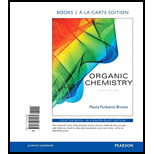
Concept explainers
(a)
Interpretation:
By substituting a chlorine for hydrogen of methylcyclohexane and converting it into a primary halide, the structure of resulting compound has to be drawn and systematic name has to be given.
Concept introduction:
Any organic molecule can be named by using certain rules given by IUPAC (International Union for Pure and applied chemistry). IUPAC name consists of three parts in major namely Prefix suffix and root word.
Prefix represents the substituent present in the molecule and its position in the root name.
Suffix denotes the presence of
Root word represents the longest continuous carbon skeleton of the organic molecule.
Nomenclature of organic molecules: The particular functional group connected into a primary carbon atom, while secondary and tertiary groups in (C2 and C3) place of carbon atoms it is called primary, secondary and tertiary structures.
(b)
Interpretation:
By substituting a chlorine for hydrogen of methylcyclohexane and converting it into a tertiary
Concept introduction:
Any organic molecule can be named by using certain rules given by IUPAC (International Union for Pure and applied chemistry). IUPAC name consists of three parts in major namely Prefix suffix and root word.
Prefix represents the substituent present in the molecule and its position in the root name.
Suffix denotes the presence of functional group if any in the molecule. It can be an alkene, alkyne, alcohol, carboxylic acid, alcohol etc...
Root word represents the longest continuous carbon skeleton of the organic molecule.
Nomenclature of organic molecules: The particular functional group connected into a primary carbon atom, while secondary and tertiary groups in (C2 and C3) place of carbon atoms it is called primary, secondary and tertiary structures.
(c)
Interpretation:
By substituting a chlorine for hydrogen of methylcyclohexane and converting it into three secondary alkyl halides the structure of resulting compound has to be drawn and systematic name has to be given.
Concept introduction:
Any organic molecule can be named by using certain rules given by IUPAC (International Union for Pure and applied chemistry). IUPAC name consists of three parts in major namely Prefix suffix and root word.
Prefix represents the substituent present in the molecule and its position in the root name.
Suffix denotes the presence of functional group if any in the molecule. It can be an alkene, alkyne, alcohol, carboxylic acid, alcohol etc...
Root word represents the longest continuous carbon skeleton of the organic molecule.
Nomenclature of organic molecules: The particular functional group connected into a primary carbon atom, while secondary and tertiary groups in (C2 and C3) place of carbon atoms it is called primary, secondary and tertiary structures.
Want to see the full answer?
Check out a sample textbook solution
Chapter 3 Solutions
Organic Chemistry, Books a la Carte Edition (8th Edition)
- Compare aldehydes and ketones as to: (Use acetaldehyde and acetone as examples). A. Reaction with cone. NaOH, heated B. Reaction with phenylhydrazinearrow_forwardWhich of the following requires a tert-butanol as öne of the reactants in Williamson ether synthesis? Select one: a. b.arrow_forward13. The ferric chloride (FeCb) solution is used as a test for: a. Alcohols d. Alkyl halides b. Phenols c. Carboxylic Acids e. Alkenesarrow_forward
- 1. Give the IUPAC name for the following compounds. CH3 a. b. с. Pharrow_forward2. Differentiate acetic acid from hydrochloric acid in terms of. a. Boiling point b. Acidity c. Solubility in ethyl alcoholarrow_forwardGive the condensed formula and name the minor and major products when hydrogen gas is added to the ff: 1. Heptene b. Nonenearrow_forward
- 1. Give the skeletal structure and the IUPAC name for: a. n-propyl propenyl ether b. isobutyl tert-butyl ether C. sec-butyl alcohol d. cyclohexyl ethyl ether e. neopentyl alcohol f. cyclobutyl phenolarrow_forwardDraw the complete Lewis electron dot structure for dichlorocarbene, :CCl₂. In the reaction of an alkene with dichlorocarbene, the dichlorocarbene is the: a. electrophile. b. Lewis base. The reaction of an alkene with dichlorocarbene is: a. regiospecific. b. Markovnikov. c. nucleophile. c. stereospecific. d. both b and c. d. non-Markovnikov.arrow_forwardThe sub-part to be solved... 4. Acetic acid reacts with a strong base forms: A. Salt B. Water C. Salt and Water D. No reaction 5. Ketones can be further oxidized with benedict's solution into: A. Alcohol B. Aldehyde C. Catalysts D. No reactionarrow_forward
- Propanenitrile undergoes acid hydrolysis to give Select one: a. propanamide. b. butanone. c. propanamine. d. propanoic acid. The formation of cyanohydrin is an example of Select one: a. Electrophilic addition b. Electrophilic substitution c. Nucleophilic addition d. Nucleophilic substitutionarrow_forwardWhat kind of reaction is the following? A. dehydration B. substitution C. radical addition D. eliminationarrow_forwardHow will you prepare the ff. 1. Decanoic Acid 2. Heptanal 3. 2-Methyl - 2-butenearrow_forward
 ChemistryChemistryISBN:9781305957404Author:Steven S. Zumdahl, Susan A. Zumdahl, Donald J. DeCostePublisher:Cengage Learning
ChemistryChemistryISBN:9781305957404Author:Steven S. Zumdahl, Susan A. Zumdahl, Donald J. DeCostePublisher:Cengage Learning ChemistryChemistryISBN:9781259911156Author:Raymond Chang Dr., Jason Overby ProfessorPublisher:McGraw-Hill Education
ChemistryChemistryISBN:9781259911156Author:Raymond Chang Dr., Jason Overby ProfessorPublisher:McGraw-Hill Education Principles of Instrumental AnalysisChemistryISBN:9781305577213Author:Douglas A. Skoog, F. James Holler, Stanley R. CrouchPublisher:Cengage Learning
Principles of Instrumental AnalysisChemistryISBN:9781305577213Author:Douglas A. Skoog, F. James Holler, Stanley R. CrouchPublisher:Cengage Learning Organic ChemistryChemistryISBN:9780078021558Author:Janice Gorzynski Smith Dr.Publisher:McGraw-Hill Education
Organic ChemistryChemistryISBN:9780078021558Author:Janice Gorzynski Smith Dr.Publisher:McGraw-Hill Education Chemistry: Principles and ReactionsChemistryISBN:9781305079373Author:William L. Masterton, Cecile N. HurleyPublisher:Cengage Learning
Chemistry: Principles and ReactionsChemistryISBN:9781305079373Author:William L. Masterton, Cecile N. HurleyPublisher:Cengage Learning Elementary Principles of Chemical Processes, Bind...ChemistryISBN:9781118431221Author:Richard M. Felder, Ronald W. Rousseau, Lisa G. BullardPublisher:WILEY
Elementary Principles of Chemical Processes, Bind...ChemistryISBN:9781118431221Author:Richard M. Felder, Ronald W. Rousseau, Lisa G. BullardPublisher:WILEY





